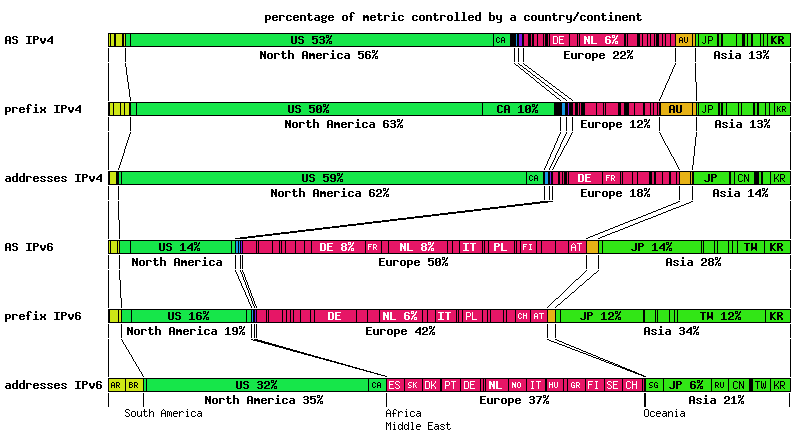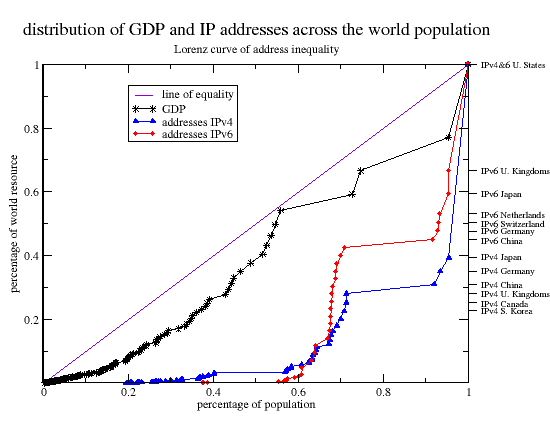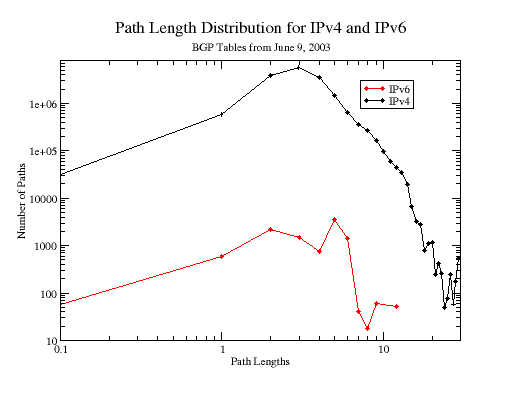IPv6 BGP Geopolitical Analysis
Analysis of distribution of IPv6 addresses, prefixes, and ASes reveals significant contrasts to previous analyses of IPv4 address space.
We gathered population and Gross Domestic Product (GDP) data for each country from the (public) United States CIA World Factbook [CIA Factbook]. We derived Internet resource data, specifically the number of IP addresses, prefixes, and autonomous systems (ASes) present in the interdomain [BGP] routing system as observed from routing tables for major Internet backbones provided by the University of Oregon's RouteViews project RouteViews]. We identified the country of origin for Internet addresses using our NetGeo [NetGeo] tool. In order to map Internet addresses to physical locations, we assume that each prefix (a contiguous block of Internet addresses) resides in the same country as the AS that originally announces that prefix into the Internet routing system.
Distribution of announced IPv4 (129673 prefixes, 15361 ASes) and IPv6 (612 prefixes, 324 ASes)

- ASes
autonomous systems, the units of BGP routing policy (either single networks or groups of networks) representing a single administrative entity and controlled by a common network administrator. The Internet is a collection of ASes whose communication is negotiated via BGP peering sessions. - prefixes
slices of Internet address space that can be independently routed - IP addresses
the absolute number of addresses that are inside a country's set of prefixes
Metrics
Discussion:
In contrast with IPv4, globally routable IPv6-addressable entities are thus far more equitably distributed among first world countries. IPv6 is a relatively new addressing system, and its strongest deployment thus far has been for research purposes or to facilitate new applications on pervasively deployed Internet-capable personal devices such as cell phones and PDAs. Technologies that use IPv6 to provide increased security will also affect IPv6 adoption in the near future.
Thus far, IPv6 has been adopted most quickly in first world countries with extensive Internet infrastructure and economically driven technical innovation. While this oligopoly in IPv6 deployment contrasts with the early U.S. monopoly on IPv4 addressing resources, it actually magnifies the inequality in Internet address resources relative to GDP. In particular, the 65% of the world population in countries without extensive Internet infrastructure experience even greater inequality in IPv6 addressing resource distribution than in IPv4 address distribution. A mitigating factor is the sheer number of IPv6 addresses, which will decrease the likelihood of hoarding by richer or more powerful nations.
Lorenz curve:
 The figure to the left plots the information in the bar chart above using a
Lorenz curve. The Lorenz curve is traditionally used in economics to
describe inequality in wealth distribution. The Lorenz curve is a
function of the cumulative proportion of ordered population groups sorted
by their corresponding size. If all groups consume the resource
equitably, the Lorenz curve is a straight diagonal line (the `line of
equality'). Unequal distributions will generate Lorenz curves below this
line. The more area between the Lorenz curve and the line of equality,
the greater is the inequality in resource distribution. We have labeled
points on the right Y-axis corresponding to the top seven countries
announcing resources into the global Internet routing system.
We note that if we were to use a population distribution granularity
finer than `country', we would see an even stronger degree of
inequality, in particular for countries like China and India, where a small
percentage of the population is connected to the Internet and a much larger
percentage is not connected.
The figure to the left plots the information in the bar chart above using a
Lorenz curve. The Lorenz curve is traditionally used in economics to
describe inequality in wealth distribution. The Lorenz curve is a
function of the cumulative proportion of ordered population groups sorted
by their corresponding size. If all groups consume the resource
equitably, the Lorenz curve is a straight diagonal line (the `line of
equality'). Unequal distributions will generate Lorenz curves below this
line. The more area between the Lorenz curve and the line of equality,
the greater is the inequality in resource distribution. We have labeled
points on the right Y-axis corresponding to the top seven countries
announcing resources into the global Internet routing system.
We note that if we were to use a population distribution granularity
finer than `country', we would see an even stronger degree of
inequality, in particular for countries like China and India, where a small
percentage of the population is connected to the Internet and a much larger
percentage is not connected.
AS Path Lengths:
 This graph compares the AS path length of IPv4 and IPv6. The main feature
that can be seen is that IPv4 graphs are much shorter then IPv6. There is
also the bimodal distribution seen in IPv6 which is not seen in IPv4,
likely reflecting a bottleneck in the topology seen
from the small number of IPv6 peers at RouteViews.
This graph compares the AS path length of IPv4 and IPv6. The main feature
that can be seen is that IPv4 graphs are much shorter then IPv6. There is
also the bimodal distribution seen in IPv6 which is not seen in IPv4,
likely reflecting a bottleneck in the topology seen
from the small number of IPv6 peers at RouteViews.
References:
| [BGP] | K. Lougheed and Y. Rekhter., RFC 1106, "Border Gateway Protocol (BGP)" |
| [RouteViews] | Meyer, D. University of Oregon RouteViews Project. |
| [NetGeo] | Moore, D., R. Periakaruppan, J. Donohoe, and K.C. Claffy. "Where in the World is netgeo.caida.org?" |

